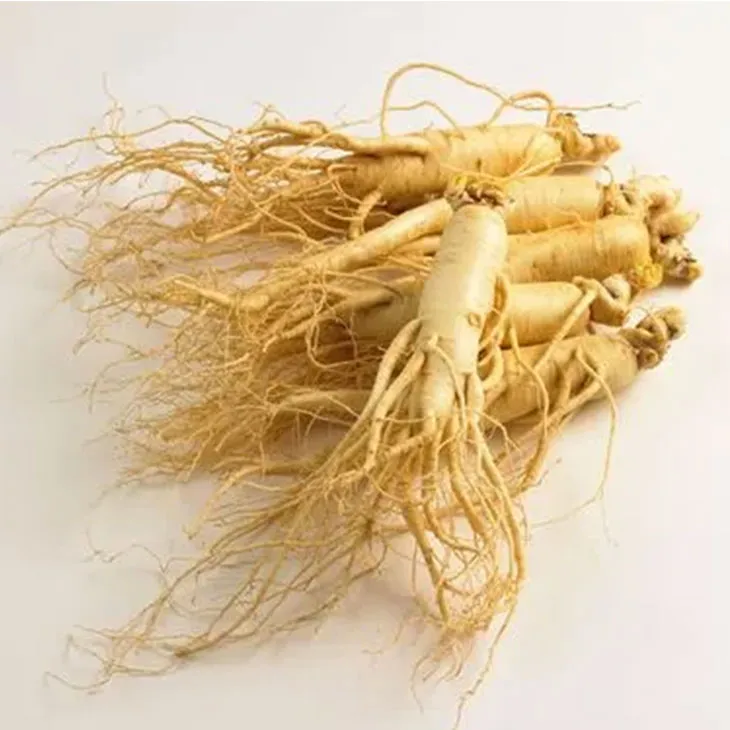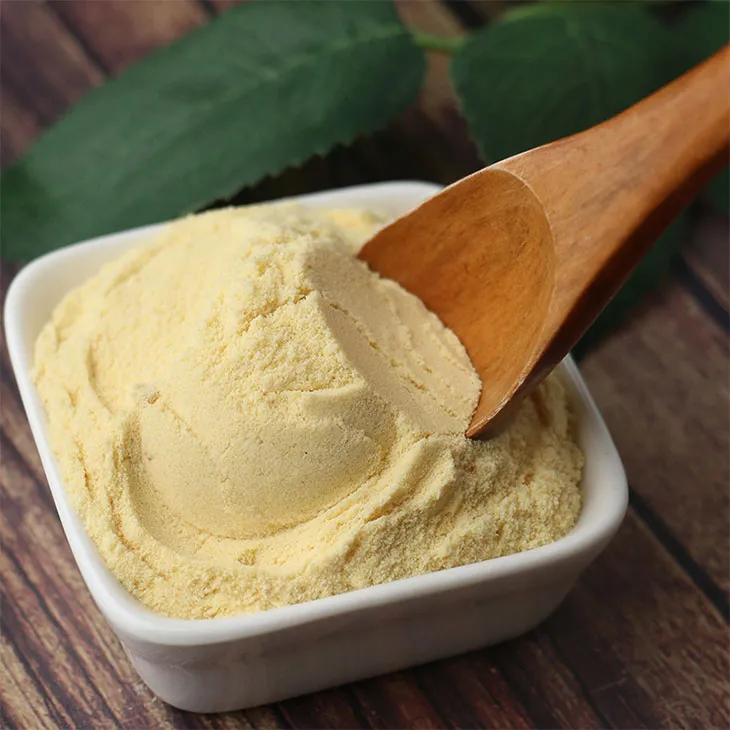- 0086-571-85302990
- sales@greenskybio.com
How to make powder from American ginseng root extract?
2024-11-26

1. Introduction
American Ginseng Root Extract is a valuable herbal substance known for its various health benefits. Converting it into powder form can increase its usability and preservation. This article will guide you through the entire process, from the initial selection of raw materials to the final production of high - quality powder.

2. Raw Material Selection
2.1 Source of American Ginseng
When choosing American ginseng root for extraction, it is crucial to ensure its quality. Wild - harvested American ginseng is highly regulated due to conservation concerns. It is often better to source from cultivated plants. Look for suppliers who follow good agricultural practices. The ginseng should be grown in suitable soil conditions and with proper irrigation and sunlight exposure.
2.2 Quality Assessment
Examine the roots carefully. They should be firm, without signs of rot or mold. The color of the root can also indicate its quality. A healthy American ginseng root typically has a light - tan to beige color. Additionally, the size and shape can vary, but larger, well - formed roots are generally more desirable as they may contain more active compounds.

3. Extraction Process
3.1 Preparation of the Roots
Before extraction, the American ginseng roots need to be properly prepared. Wash the roots thoroughly to remove any dirt or debris. It is advisable to use lukewarm water and gently scrub the roots. Once clean, allow the roots to dry completely. This can be done by air - drying in a well - ventilated area or using a low - heat drying method to avoid damaging the active components.
3.2 Solvent Selection for Extraction
There are different solvents that can be used for extracting the active compounds from American ginseng roots. Ethanol is a commonly used solvent as it is effective in dissolving many of the bioactive substances such as ginsenosides. However, water - based extraction methods are also available for those who prefer a more natural or alcohol - free option. The choice of solvent depends on the desired end - product and the extraction equipment available.
3.3 Extraction Procedure
- Once the roots are dry and the solvent is selected, place the roots in a suitable extraction vessel. If using ethanol, a glass container with a tight - fitting lid is recommended to prevent evaporation.
- Add the solvent to the vessel, ensuring that the roots are completely submerged. The ratio of roots to solvent can vary depending on the concentration desired, but a common ratio is about 1:5 (roots:solvent by weight).
- Allow the mixture to soak for a period of time. This can range from several days to a few weeks. During this time, the solvent will extract the active compounds from the roots. Stir the mixture occasionally to enhance the extraction process.
- After the soaking period, filter the mixture to separate the liquid extract from the solid root material. A fine - mesh filter or filter paper can be used for this purpose.

4. Concentration of the Extract
4.1 Evaporation Method
To concentrate the extract, one of the most common methods is evaporation. If using an ethanol - based extract, this can be done in a well - ventilated area or under a fume hood to avoid the inhalation of ethanol vapors. Place the extract in a shallow dish or a rotary evaporator if available. Gently heat the extract to allow the solvent to evaporate. The temperature should be kept relatively low to prevent the degradation of the active compounds. As the solvent evaporates, the extract will become more concentrated.
4.2 Freeze - Drying (Optional)
For a more gentle and potentially higher - quality concentration method, freeze - drying can be considered. Freeze - drying involves freezing the extract first and then subjecting it to a vacuum to remove the water or solvent. This method can help preserve the integrity of the active compounds better than simple evaporation. However, freeze - drying equipment can be expensive and may not be accessible to all.

5. Drying the Concentrated Extract
5.1 Oven - Drying
If the extract has been concentrated through evaporation, further drying may be needed to convert it into a powder. An oven can be used for this purpose. Set the oven to a low temperature, typically around 40 - 50°C. Place the concentrated extract in a suitable container, such as a glass dish or a silicone baking mat. Leave the extract in the oven until it is completely dry. Check the progress regularly to ensure that it does not over - dry or burn.
5.2 Desiccator Drying
Another option for drying the concentrated extract is using a desiccator. A desiccator contains a drying agent, such as silica gel or calcium chloride, which absorbs moisture from the air. Place the concentrated extract in a container and put it in the desiccator. This method can be slower than oven - drying but can provide a more controlled drying environment, especially for extracts that are sensitive to heat.
6. Grinding the Dried Extract into Powder
6.1 Selection of Grinding Equipment
There are several types of equipment that can be used for grinding the dried extract into powder. A mortar and pestle can be used for small - scale grinding. For larger quantities, an electric grinder or a mill is more suitable. When choosing a grinder, consider the fineness of the powder required. Some grinders are designed to produce a very fine powder, while others may result in a coarser texture.
6.2 Grinding Procedure
- If using a mortar and pestle, place the dried extract in the mortar. Use a gentle, circular motion with the pestle to break up the extract into smaller pieces. Gradually increase the pressure as the extract becomes more fragmented.
- If using an electric grinder, place the dried extract in the grinder chamber. Make sure the grinder is clean and dry before use. Turn on the grinder and let it run until the extract is ground into a powder. Some grinders may require multiple passes to achieve the desired fineness.
7. Quality Control and Storage
7.1 Quality Control
Once the powder is produced, it is important to conduct quality control tests. Analyze the powder for the presence and concentration of key active compounds, such as ginsenosides. This can be done using laboratory techniques such as high - performance liquid chromatography (HPLC). Additionally, check the powder for purity, ensuring that there are no contaminants or foreign substances. The particle size distribution can also be measured to ensure consistency in the powder's texture.
7.2 Storage
Proper storage is essential to maintain the quality of the American Ginseng Root Extract powder. Store the powder in an airtight container, preferably made of glass or a high - quality plastic. Keep the container in a cool, dry place, away from direct sunlight. Exposure to heat, moisture, and air can cause the degradation of the active compounds in the powder. Additionally, label the container with the date of production, the source of the ginseng, and any other relevant information for traceability.
8. Precautions
8.1 Safety Precautions during Extraction
When handling solvents such as ethanol during the extraction process, take appropriate safety precautions. Work in a well - ventilated area to avoid the inhalation of solvent vapors. Wear appropriate protective gear, such as gloves and safety glasses. Ethanol is flammable, so keep it away from open flames and heat sources.
8.2 Avoiding Contamination
Throughout the process, from raw material selection to powder production, take steps to avoid contamination. Keep all equipment clean and sanitized. Use clean utensils and containers for handling the roots, extract, and powder. Contamination can affect the quality and safety of the final product.
9. Conclusion
Making powder from American Ginseng Root Extract involves a series of carefully controlled steps, from raw material selection to final production and quality control. By following the proper procedures and taking necessary precautions, it is possible to produce high - quality powder that can be used for various applications in herbal medicine and natural product manufacturing.
FAQ:
Q1: What are the key factors in selecting raw materials for making American Ginseng Root Extract powder?
The key factors in raw material selection include the quality and origin of the American ginseng roots. High - quality roots should be fresh, free from diseases and pests, and preferably sourced from regions known for their good - quality ginseng production. The age of the roots also matters, as older roots may contain more active ingredients. Additionally, proper harvesting and storage methods of the raw materials are crucial to ensure the quality of the final powder.
Q2: What tools are required for making powder from American Ginseng Root Extract?
Some of the essential tools include a grinder or a mill to break down the extract into a fine powder. A drying apparatus may be needed if the extract is not already in a dry form. Measuring tools such as scales are also necessary to ensure accurate proportions during the process. Additionally, containers for storing the powder and sieves for filtering out any large particles or impurities can be useful.
Q3: Are there any specific precautions during the powder - making process?
Yes, there are several precautions. Hygiene is of utmost importance. All tools and containers should be thoroughly cleaned and sterilized before use to prevent contamination. Temperature control is also crucial. If drying is involved, it should be done at an appropriate temperature to avoid damaging the active ingredients in the extract. Moreover, handling of the American Ginseng Root Extract should be done carefully to prevent any loss of valuable components.
Q4: How can one ensure the quality of the American ginseng root extract powder?
To ensure quality, strict quality control measures should be implemented throughout the process. This includes starting with high - quality raw materials, following proper extraction and powder - making procedures, and conducting regular tests for purity, potency, and the presence of contaminants. Using standardized manufacturing processes and following good manufacturing practices (GMP) can also contribute to the production of high - quality powder.
Q5: Can the powder - making process affect the potency of American ginseng root extract?
Yes, the powder - making process can potentially affect the potency. If not done correctly, for example, if the extraction process is incomplete or if the powder is exposed to unfavorable conditions such as excessive heat or moisture during production, the potency of the active ingredients may be reduced. Therefore, it is important to follow the correct procedures to preserve the potency of the American ginseng root extract.
Related literature
- American Ginseng: Botany, Horticulture, and Utilization"
- "The Chemistry and Pharmacology of American Ginseng"
- "Processing and Quality Control of Herbal Extracts: A Focus on American Ginseng"
- ▶ Hesperidin
- ▶ citrus bioflavonoids
- ▶ plant extract
- ▶ lycopene
- ▶ Diosmin
- ▶ Grape seed extract
- ▶ Sea buckthorn Juice Powder
- ▶ Beetroot powder
- ▶ Hops Extract
- ▶ Artichoke Extract
- ▶ Reishi mushroom extract
- ▶ Astaxanthin
- ▶ Green Tea Extract
- ▶ Curcumin Extract
- ▶ Horse Chestnut Extract
- ▶ Other Problems
- ▶ Boswellia Serrata Extract
- ▶ Resveratrol Extract
- ▶ Marigold Extract
- ▶ Grape Leaf Extract
- ▶ blog3
- ▶ blog4
-
Chinese Withania somnifera Extract Factory.
2024-11-26
-
中国松树皮提取物粉粉末供应商
2024-11-26
-
High - quality Marigold Extract Products.
2024-11-26
-
100% Pure Natural Mango - Flavored Powder.
2024-11-26
-
Hawthorn powder
2024-11-26
-
Chasteberry Extract
2024-11-26
-
Epimedium extract powder
2024-11-26
-
Beetroot Powder
2024-11-26
-
Boswellia Serrata Extract
2024-11-26
-
Purple Sweet Potato Extract
2024-11-26
-
Sophora Japonica Flower Extract
2024-11-26
-
Mulberry Extract
2024-11-26
-
Dandelion Leaf Extract
2024-11-26
-
Lotus leaf extract
2024-11-26





















